The presence of a washing machine is no surprise to anyone. Therefore, everyone should know how to solve certain problems that arise with this technique. One of these is the drain hose for the washing machine. In this article, we will talk in more detail how to solve the problem. There are only 2 exits:
- Purchasing a new hose of the required length.
- Extend an existing tube.
Geometric features
In order to replace or increase drain tube, you need to understand the features of it geometric device. As a rule, the installation of the supplied tube has already been carried out by the manufacturer. This provides absolute protection against leaks and other malfunctions of this part.
Washing machines are designed so that the water pressure does not exceed a certain pressure, while draining the water from the pipe can be stopped with a finger:
- Given this factor, the top point of the hose should not be higher than 100 cm. Otherwise, the pump simply will not be able to push the water out.
- On the other hand, the same point must be at least 60 cm from the lower point of the fixture. Meaning minimum height always indicated in the installation and operating instructions. This recommendation it is needed so that when water enters the drum of the machine, it does not immediately overflow into the sewer.
Important! To organize the drain into the drain of the kitchen sink, it is recommended to use a height of 90 cm. This avoids periodic blockages.
Drain hose extension process
Before extending the washing machine drain hose, you will need to purchase:
- A drain pipe of the required length, of the same brand as in the kit.
- Hose connector.
- Clamps for clamping.
The elongation process itself is conditionally divided into 3 stages:
- Purchase required material appropriate for your washing machine model. If it is impossible to find an identical tube, you need to find the most similar in characteristics, the most important of which is the diameter.
- Preparing to install an extension cord. The entry of the connector into the water drain hose must be very tight. The connection points must be in the middle of the tube.
- Fixing the tips with clamps. The tightness of the tightening must be strong enough to prevent breaks and subsequent leakage.
Important! Before starting the machine, once again check all fasteners for reliability. The most appropriate would be gluing the tubes together - this provides the most reliable sealing.
Hose types
No matter what the function drain hose washing machine is always one - outlet dirty water, the market provides several of its varieties:
- Regular fixed length hose - varies from 1 to 5 meters. If necessary, it can be extended.
- Telescopic type - enough universal option. Such parts are sold in a compressed form, and when stretched, they increase their length up to 3 times. They also have their drawbacks. Hoses of this type are most prone to damage and blockages.
- Hose in the bay. It is a long tube with a module of 50-55 cm. It is convenient because it can be cut off at a notch made according to the module. So - the required length can be done by yourself.
Among general characteristics For each type, the following can be distinguished:
- The material of manufacture is polypropylene.
- At the ends there are so-called fittings with a diameter of 19 to 22 mm, made of rubber.
Ways to organize a drain
Drainage of water can be carried out in several ways. The thoughtfulness of the design of the drain system largely depends on this. Let's analyze the most popular options:
- Drain into a sink or bathroom. For this method, it is enough to insert the water drain hose into the holder and direct it to the bathroom or sink. This method is used when it is impossible to connect to the sewer or if the car is temporarily used in this place.
Important! This option has its drawbacks: inability to use the bathroom / sink for washing, pollution due to waste water, unpleasant appearance device operation.
- Connection to the sewer with a siphon. The best option for many occasions. Adequate sealing is provided with ease of use.
Important! The disadvantage of such a system is that it occupies a certain place.
- Installation directly into the sewer through the cuff. In this method, it is necessary to ensure that there is a margin for the length of the drain hose of the washing machine. The hose must not be taut, as vibrations can damage the connection, resulting in leakage.
- Siphon with check valve. This connection method is rarely used in our time, since in most apartments there is no special place for devices such as washing or dishwasher.
Important! This type of mechanism significantly outperforms the previous ones, as it has a protection system against unpleasant odors and the return of water into the equipment.
Each washing machine is individual, respectively - the instructions for replacing the hose are different everywhere. But there are a number general rules for each of them:
- First of all, you need to turn off the machine from the mains. In this case, fix the power cord on the back of the device.
- The next step is to turn off the water supply. In this case, attention must be paid to the laying of the pipe. You can't let her get lost.
- At the place where the drain is attached, you need to put a plug, and fix the drain hose for the washing machine on back wall pipe up.
- Next, you should gain access to the place where the hose is fixed - usually this is a connection to the drain pump of the device.
- Next, the tube is disconnected and removed. You also need to disconnect it from the sewer system and carefully drain the remaining water.
- The last step is to replace the old hose with a longer new one.
Important! How to get to the washing machine drain system itself is carefully described in the operating instructions from each manufacturer. It also provides instructions for installing a new pipe.
Installing a water drain hose is a fairly simple matter if you understand some of the subtleties described above. And this means that you most likely will not need the help of a specialist, and you will successfully mount everything yourself. Remember, following the instructions is the key to success.
Anyone should connect to plumbing system houses or apartments: for this, a special inlet hose for a washing machine is used. It must be installed between it and the system in order to quickly shut off the flow of water in emergency cases or for maintenance work. important detail. You have to buy a new water supply hose, and here various surprises await the user. To purchase a truly reliable product, you need to know its types, as well as the approximate cost.
The water supply device has a simple design: the base is PVC tube, which is reinforced with reinforced thread and nylon braid. The product can withstand pressure drops in the plumbing system, has decent tensile strength.
At both ends of the device there are special fitting for connection to the plumbing system. The fittings are locked with plastic nuts, the length of the hose varies between 1-5 meters. If the machine is installed at a distance from the water supply system, then the connecting device is purchased the longest.
Master's advice! When connecting, do not make great efforts, use tools: do everything with your hands. Remember that fittings and nuts are made of plastic and can break easily.
For reliability and elimination of leaks, it is possible to seal the connections with a special tape. If the filling device is out of order, then it is not worth repairing it. Buy a new, better one, this way you will protect yourself from trouble.
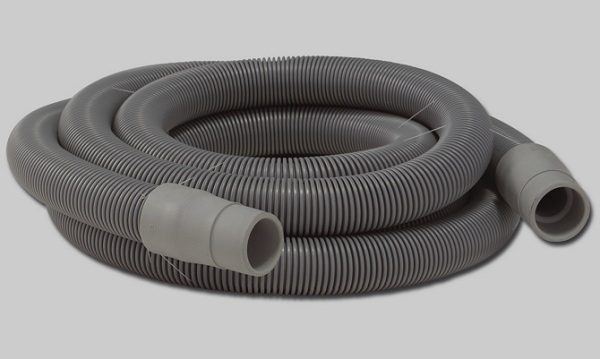
Characteristics
Now let's move on to a description of the main parameters of the hose for supplying water to the washing machine: correctly selected dimensions will help install the device in a place convenient for the hostess, and not where the connection goes.
The main hose parameters for a modern washing machine are as follows:
- Length. It is of primary importance during installation. Experts do not recommend leaving the device in a taut position, because there is a risk of unexpected leakage.
- Strength capable of withstanding various pressure drops. Even experienced plumbers will not be able to tell you the exact force with which water presses on the entire system. Therefore, buy with a decent margin of safety, this will save yourself from unnecessary problems.
- The maximum water temperature in the machine is considered to be 90 ° C (boiling and functions), so the hoses are selected heat-resistant.
Majority foreign manufacturers they make filling and draining devices from the same material, therefore they guarantee that at 100 0 C they will function reliably and well.
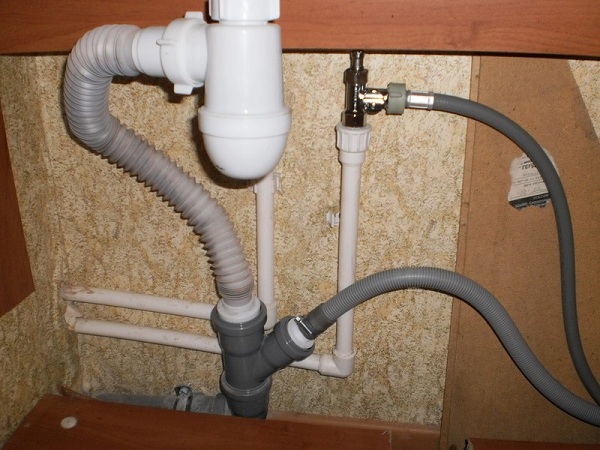
All materials age over time, and even the most durable washing machine hose can break over time, flooding your neighbors. There is a way out: immediately buy a reinforced product with to eliminate such a misunderstanding.
The UDI valve is inside, it copes with the problem in a matter of seconds. In appearance, this is an ordinary device, only having a build-up on the side where the hose is connected to the water supply: there is a tricky system that blocks the flow of water in the event of a rush. The body of the aquastop device is made of stainless steel, which protects it from mechanical damage.
The system is sensitive to pressure drops, instantly shutting off the water supply. When testing the protection unit, they specially cut sharp knife hose, but the water was shut off for a second, so there was no flood.
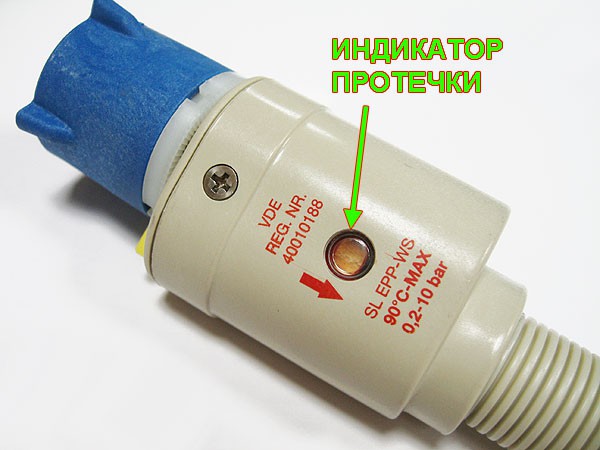
Aquastop works according to the following principle:
- In normal mode, water is supplied through the internal, main supply channel.
- When damage occurs, water acts on special material surrounding the main product, as a result, it swells sharply. A valve is activated that shuts off the flow of water from the water supply, and the floor remains almost dry.
These devices are different from the classic more high price, which varies in the range of 500-600 rubles, but they give a full guarantee against leaks.
There is an Aquastop system based on powder valve to prevent small leaks if the water supply hose is damaged, but it costs three times as much. Unlike the UDI valve, this system is disposable, it is not able to save you from sharp breaks. However, everyone decides for himself what kind of protection to use to ensure security.
Wrong position
When connected filling device the main task is to ensure a high-quality flow of water to the washing machine. To do this, the hose must be in the only correct position without tension or kinks. Plastic fittings should not pinch the rubber gasket, but have the same effect on the connection to the machine and the water supply.
If, after installation, drops appear from under the connection, turn off the water supply and reconnect - it is possible that the gasket was clamped with an offset.
Professional plumbers say that it is better to connect the hose to the washing machine once reliably than to do expensive repairs from the neighbors below.
In front of the filling system, some users install mechanical, which will prevent small particles from entering the inside of the machine, although the design of the machine implies the presence of a special similar device. This is done in order to double the security.
In conclusion, advice from a professional: if the machine is installed at a distance of more than 3 meters from the water supply system, make a branch from metal-plastic pipe . It is hundreds of times more reliable than any durable hose. Make further connections in the same way as previously written tips.
A curious hostess, of course, will turn her attention to the fact that the hose for supplying water to the washing machine is very different from the one through which the waste liquid goes into sewer system. What is it for?
The fact is that tap water enters under a certain pressure. Somewhere it is stronger, somewhere weaker, but it is always present. And since there is something that presses, then there is a danger of a break. Therefore, such a difference between the drain and inlet hoses.
The first is made of plastic and has a corrugated shape, it does not have a rigid mount. The second one was made according to a special reinforced technology. What does it mean? Polyvinyl chloride (special rubber), from which the tube is made, is reinforced with a braid of durable synthetic thread or steel wire. At different manufacturers various materials but the design is the same. Thanks to it, the hose for connecting the washing machine to the plumbing system is able to withstand a pressure of up to 20 bar. That is, for each centimeter of the pipe, water presses with a force of a little more than 20 kg. This is enough to break a simple plastic hose.
Therefore, the fastening of the hose for supplying water to the machine is made reinforced. Nuts are fixed on the ends crimped with metal brackets, which securely fasten the hose to the machine itself and to the water pipe. Without this, the trouble with the flood cannot be avoided.

What is the product provided with?
In some homes, the water pressure is so strong that an ordinary reinforced hose cannot withstand it. Therefore, manufacturers have developed a special system called "Aqua-stop". It is able to prevent a flood even if the hose bursts.
How it's done? The main tube through which water gets inside the washing machine is hidden inside another pipe. At the ends of such a double hose there is either a container with a special powder or a solenoid valve.
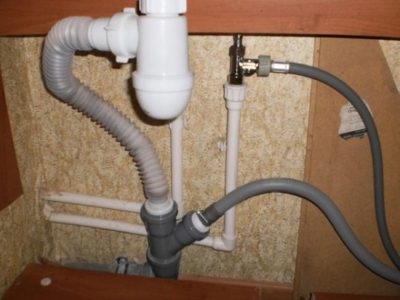
In the event of an accident, water begins to fill the space between the tubes, and upon contact with the powder, chemical reaction. The substance swells and blocks the access of water to the machine.
The system with a valve works in the same way, which reacts to the liquid and automatically works as a locking mechanism. The flood stops at the very beginning, and the owners of the apartment are saved, and at the same time the neighbors below.
Some manufacturers supply their hoses with special sensors that should react if a rupture occurs in the place where the hose is crimped and connected to the nut. As soon as the water starts to flow outside, it falls into a special pan. Special floats are fixed here, which rise and turn on the emergency shut-off of the hose.
Well, the most expensive supply hoses tap water They also have a dedicated pump. It turns on during an accident and pumps out the liquid so that it does not leak out.
Hoses with the Aqua-stop system are sold both as a complete set with the machine and separately. Of course, they cost more than a simple hose. But by installing such a tube with a fuse system, you can be sure that nothing will happen during the absence of the owners in the house.
What to look for when buying?
And now we will analyze the main parameters of the hoses for supplying water to the washing machine. Knowing these features will help not only choose a reliable connector, but also create comfortable conditions for the operation of the machine. And the right dimensions, by the way, will make it possible to put it where the hostess wants, and not where it turns out.

Length plays an important role. Thanks to reasonably selected parameters, the hostess has the freedom to choose the place where the machine will stand.
Manufacturers produce products with a length of 1 to 5 m.
Experienced craftsmen advise buying a hose that will not be in a taut position. This will increase the risk of an accident, especially where the hose is connected to water pipe or with a washing machine. But you should not create extra loops from the tube either. It is best to choose in advance a place to install the washing machine and measure the desired length.
Aged internal pressure- the second important parameter by which you need to make a choice. It is rather difficult to know with what real force the tap water presses on the pipes. There is a suspicion that even the employees of the water company will not be able to name exact figure. Therefore, it is better to buy a hose with a margin of safety.
When studying offers, it is important to understand the difference between working pressure and maximum. The first indicator indicates that the hose is able to work normally only at a certain indicator. The second one shows how much force the material can withstand in the event of a sharp jump in water pressure in the pipeline. Therefore, you need to find out from the seller both the first and second indicators.
For those who live in apartment buildings on a high floor, will be sufficient if operating pressure will be within 20 bar. For those who live in private homes, it is better to take the phone with a margin of safety.
Not the least important indicator is the maximum temperature that the hose material can withstand. If the maximum washing temperature is 90 °C (boil function), then the material designed for 50 °C will simply melt. Therefore, the choice must be stopped on the model that will endure, without harm to itself, a higher temperature than that declared maximum for the washing machine at home.
Note that most manufacturers produce products that can withstand up to 100 ° C. Therefore, the problem with choosing the right temperature regime for the tube should not occur.
In order for water to enter the washing machine, it is connected with a hose to the water pipe. Usually a branch with a tap is created here so that you can quickly shut off the water supply. How to choose a suitable faucet for connecting a washing machine, we have already told you earlier. The inlet hose for the washing machine is supplied with the machine itself - you do not have to buy it separately.
But what if it needs to be replaced? There can be many reasons for this - leaks, damage to the sheath, unsuitable length, poor quality standard hose. And in order to buy a really good hose, you need to understand their varieties. This is exactly what will be discussed in our review.
Types of inlet hoses for a washing machine
Inlet hose for a washing machine has a fairly simple device. It is based on a PVC tube reinforced with reinforced threads and a nylon braid. Such a multilayer "sandwich" makes it possible to rely on the strength of the hose - it has a high tensile strength and can withstand high pressure water.
The ends of the inlet hoses are reinforced with metal sleeves, from which fittings and nuts peep out - one of the fittings is screwed to the washing machine, and the other to the water pipe. Nuts and fittings are made of plastic. Their margin of safety is not so great, so you need to tighten the nuts with your hands, not with wrenches - this way we can avoid damaging them.
This design of the inlet hose can be called the most common- these are the hoses that are supplied with washing machines. Their length is usually limited. And if the washing machine will be installed at a distance from the water supply, we will need a longer hose. Such hoses are purchased separately, and their length varies from one to 5-6 meters.
If necessary, the length can be increased by connecting several hoses using a special connector. In order to avoid water leaks, the junction is sealed with FUM tape. But it is best not to use such connections due to their reduced reliability.
Does the hose you bought look different? Easy to bend and wrinkle at any angle? Doesn't have a strong reinforced braid? In this case, its operation can lead to sad consequences, manifested in the form of leaks.
Is the inlet hose for the washing machine disassembled? Of course, anything can be taken apart. But the damaged hose is best thrown away and replaced with a new one. This approach will help to avoid accidental leaks - a new hose with serviceable fittings is always stronger than an old and repaired one.
Inlet hoses with Aquastop system

Leak-proof hoses are called Aquastop. Ordinary hoses, which we wrote about above, can break - this sometimes happens due to their natural aging. And if water from them gets on the floor, it can easily flood the neighbors. In order to prevent such a problem, hoses with the Aquastop system were invented.
The hose with the Aquastop protective block is a design in which one tube passes inside the other. A special material is placed between the tubes, which swells under the action of water and triggers a safety valve that shuts off the water. That is, the system works like this:
- In normal mode, water flows through the internal, main hose;
- At the moment of hose damage (break or slow leak), water comes into contact with the swellable material;
- The valve is activated, the water is shut off, the floor in the room remains dry.
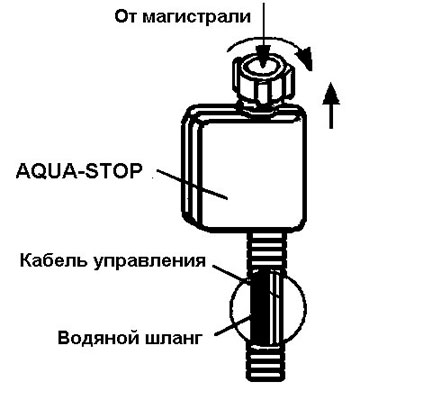
These hoses are significantly more expensive than their classic counterparts, but provide reliable protection from leaks. There are situations when the washing machine draws water in the off state, here the hose with the Aquastop system will not save you from leakage.
How to connect the inlet hose to the washing machine
Some experts recommend installing an additional mechanical filter, purifying water (in addition to the mesh already standing at the entrance to the washing machine). Thanks to this, the machine will be reliably protected from pollution. The filter is placed after the tee, before the hose.
What to do if the washing machine is installed away from the water supply? In this case, we can use a serial connection of several hoses. But the most reliable scheme will be laying an additional plastic pipe to the installation site of the washing machine - thus we are more likely to avoid possible leaks. Naturally, the shut-off valve is still placed at the very beginning of the tie-in to the main water supply.
Making a connection plastic pipes, it is recommended to use special tool. After the end of the wash, you need to block the access of water to the washing machine.
How to tighten the inlet hose correctly? Some users put a decent amount of effort here, but it's not worth it - there is a high risk of damage to the plastic nuts. They need to be twisted with bare hands, without the use of tools and other improvised means that increase effort. All we need is to ensure a tight connection, in which the nut will not unscrew, and the junction will not let water through.
How to properly position the inlet hose
The inlet hose for the washing machine can be placed in any position. But strong bends are not recommended as this may cause it to break. Location restrictions apply to drain hoses - it should not be located above a certain line indicated in the instructions for a particular machine (as a rule, no higher than the upper edge of its body).
To connect the washing (dishwasher) machine to the water supply and sewerage systems, special hoses are used. The hose for the washing machine can be installed independently. The main thing is to choose the right device so that it lasts a long time.
Inlet hose
The water supply hose connects the washing machine to and serves to fill household appliances the required fluid.
Kinds
The inlet hose can be of the following form:
- rubber water hose;

- reinforced (standard rubber hose is protected by an additional layer, which gives it additional strength). Metal, nylon are used to reinforce the rubber hose;

- rubber hose for water supply with Aquastop system. An additional tube is located in the main hose. When a hose breaks inner space filled with water, which activates the mechanism automatic shutdown water supply.
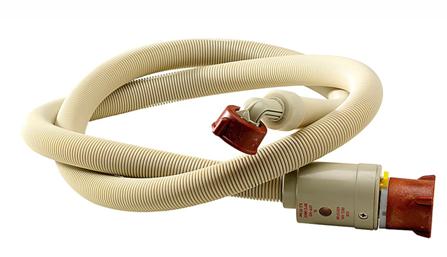
Inlet hoses differ in service life and cost of products. The cheapest and most short-lived is a regular rubber hose. The most expensive is a hose with a leak protection system.
Selection rules
How to choose a hose for connecting water supply? When choosing, it is recommended to pay attention to the following factors:
- operating pressure that the hose can withstand. For apartment buildings suitable products designed for 20 bar. For private homes, this parameter is recommended to be increased by 5-10%;
- Maximum temperature. It is advisable to select hoses designed for temperatures of 90 degrees or more. Standard hoses are available with a margin of safety and are able to withstand temperatures of 100ºС;
- hose length. When determining the parameter, it is important to consider the distance between household appliances and water pipe. The hose must not be connected with tension or excessive kinks. Tension or kinks will reduce the life of the product.
Wiring diagram
How to connect the hose to washing machine? It is necessary to act according to the following scheme:
- cut into the water pipe. A tee and a separate valve are installed at the tie-in site for local shut-off of the water supply;
- a straight end is connected to the tee faucet. The union nut mounted on the hose is equipped with rubber gasket, but for additional sealing threaded connection you can use FUM tape;

At the junction of the inlet hose with the water pipe, experts recommend installing an additional filter that will protect household appliances from small particles of debris contained in the water.
- the bent end of the hose is connected to the corresponding inlet of the washing machine. Upon purchase, the hose hole is protected by a plug, which is removed immediately before installation;
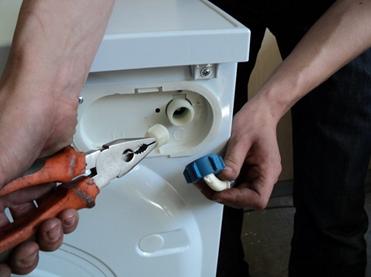
- the performance and tightness of the filling system of household appliances is checked.
Drain hose
The drain hose is designed to drain waste water from the washing machine.
Hose types
The washing machine drain hose is made of polypropylene. Fittings for connecting the device are located at the ends of the hose.
Available in stores the following types hoses:
- standard hose of a certain length. Manufacturers produce hoses from 1 m to 5 m long;
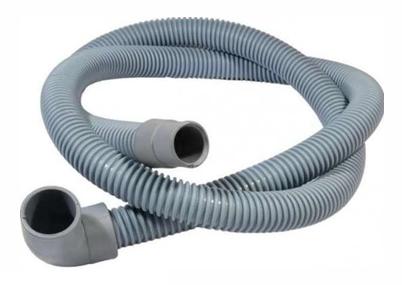
- telescopic hose. Corrugated hose can be stretched to the desired length. This eliminates the possibility of the formation of unnecessary kinks. The main disadvantage of a telescopic hose is its susceptibility to blockages, since the inner surface of the hose is also corrugated.

Drain hose connection diagram
Connecting the drain hose for the dishwasher (washing machine) directly to household appliances is quite simple. It is necessary to fix the end of the hose to the pump that pumps out water.

In most cases, you will need to remove the rear cover of the machine to replace the hose.
Difficulties among users are caused by the arrangement of drains from household appliances. Drainage of water can be carried out:
- in a sanitary ware located near household appliances, for example, in a bath. To do this, you must additionally purchase a holder for the drain hose, which will fix the hose in a certain position;

- into a siphon connected to plumbing. To equip the drain, you will need a siphon with an additional compartment and a holder. At the junction of the hose and siphon, a rubber cuff;

- directly in . To equip the drain into the sewer, you will need to organize a special outlet, which is carried out by inserting a tee and a rubber cuff that makes the joint tight.

If the length of the drain hose is not enough to connect household appliances, then the parameter can be increased. How to extend the hose? For this, a special adapter is used that connects two hoses into one system. The adapter is fixed using crimp clamps.

Extension of the hose without the use of adapters is prohibited, since it is impossible to achieve complete tightness of such a connection.
All stages of installation and connection of the washing machine are presented in the video.
By following these simple rules, you can select and replace the drain and inlet hose on your own.


















